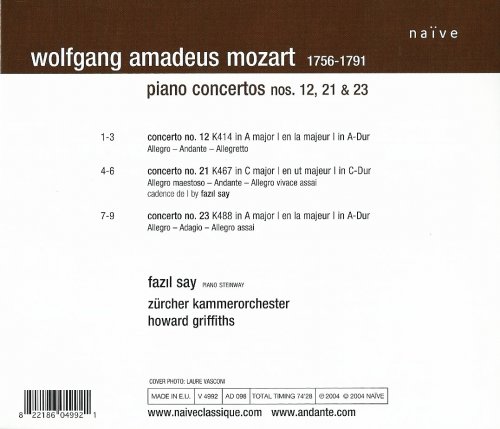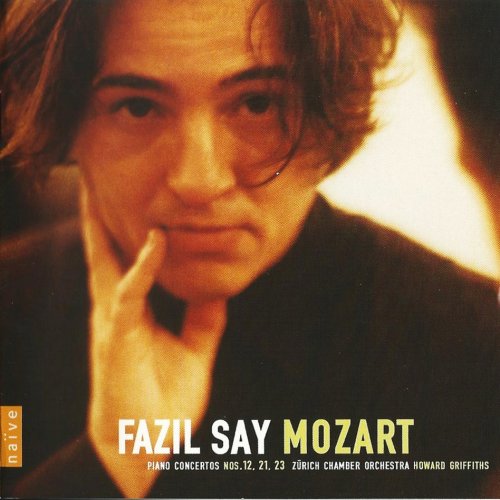
Fazil Say - Mozart: Piano Concertos Nos. 12, 21 & 23 (2004) CD-Rip
BAND/ARTIST: Fazil Say
- Title: Mozart: Piano Concertos Nos. 12, 21 & 23
- Year Of Release: 2004
- Label: Naive
- Genre: Classical
- Quality: FLAC (image+.cue,log,scans)
- Total Time: 01:14:34
- Total Size: 329 Mb
- WebSite: Album Preview
Tracklist:
Concerto No. 12 K414 In A Major
1. Allegro
2. Andante
3. Allegretto
Concerto No. 21 K467 In C Major
4. Allegro Maestoso
5. Andante
6. Allegro Vivace Assai
Concerto No. 23 K488 In A Major
7. Allegro
8. Adagio
9. Allegro Assai
Performers:
Fazil Say - piano
Zürcher Kammerorchester
Howard Griffiths – conductor

Concerto No. 12 K414 In A Major
1. Allegro
2. Andante
3. Allegretto
Concerto No. 21 K467 In C Major
4. Allegro Maestoso
5. Andante
6. Allegro Vivace Assai
Concerto No. 23 K488 In A Major
7. Allegro
8. Adagio
9. Allegro Assai
Performers:
Fazil Say - piano
Zürcher Kammerorchester
Howard Griffiths – conductor
Before talking to Fazil Say about these performances, I’m not sure that I would have used the word “operatic” to describe them—but from the beginning, I was struck by their conversational quality, by the superbly characterized playing of the solo winds and by the exceptional chamber-music rapport of pianist and orchestra as they toss material back and forth. And while I might not have thought of the word “smiling,” I certainly noticed the high level of wit, both in the playing itself and in the slightly anachronistic cadenza that Say offers for K 467.
More generally, these are first-rate performances that are consistently joyful and consistently winning in their poise: finely, but never garishly, colored (listen, for example, to the magical ending of the second movement of K 488); clean, but never antiseptic; imaginatively voiced, but never fussy or arbitrary in their treatment of secondary lines; energetic, even on occasion breathless, but never hectic, much less aggressive. And while the piano does “sing,” as Say hopes it will, these are not, as that observation may lead you to fear, in any way soft-centered readings. The rhythms are far from rigid (note, in particular, the way he leans into cadences); but there is plenty of kick, plenty of dynamic contrast, plenty of bite to the articulation; and the phrasing consequently has a sharp profile. Not even in the popular middle movement of K 467, with its darker emotional undercurrents, does Say veer toward the sentimental.
Granted, this is a crowded field, and I wouldn’t want to be without, say, the very different performances by Ashkenazy, Lipatti, and Schnabel in K 467 or by Pollini or Rubinstein in K 488. Still, it says a lot that these new performances can be mentioned in the same breath as those classics—and I’d argue that Say’s zip through K 414 stands higher yet. The sound is excellent, too (the antiphonal separation of the first and second violins pays high dividends here). All in all, a distinguished release. -- Peter J. Rabinowitz
More generally, these are first-rate performances that are consistently joyful and consistently winning in their poise: finely, but never garishly, colored (listen, for example, to the magical ending of the second movement of K 488); clean, but never antiseptic; imaginatively voiced, but never fussy or arbitrary in their treatment of secondary lines; energetic, even on occasion breathless, but never hectic, much less aggressive. And while the piano does “sing,” as Say hopes it will, these are not, as that observation may lead you to fear, in any way soft-centered readings. The rhythms are far from rigid (note, in particular, the way he leans into cadences); but there is plenty of kick, plenty of dynamic contrast, plenty of bite to the articulation; and the phrasing consequently has a sharp profile. Not even in the popular middle movement of K 467, with its darker emotional undercurrents, does Say veer toward the sentimental.
Granted, this is a crowded field, and I wouldn’t want to be without, say, the very different performances by Ashkenazy, Lipatti, and Schnabel in K 467 or by Pollini or Rubinstein in K 488. Still, it says a lot that these new performances can be mentioned in the same breath as those classics—and I’d argue that Say’s zip through K 414 stands higher yet. The sound is excellent, too (the antiphonal separation of the first and second violins pays high dividends here). All in all, a distinguished release. -- Peter J. Rabinowitz

Classical | FLAC / APE | CD-Rip
As a ISRA.CLOUD's PREMIUM member you will have the following benefits:
- Unlimited high speed downloads
- Download directly without waiting time
- Unlimited parallel downloads
- Support for download accelerators
- No advertising
- Resume broken downloads


